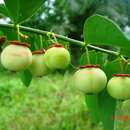en
names in breadcrumbs


Breynia is a plant genus in the family Phyllanthaceae, first described in 1776. It is native to Southeast Asia, China, the Indian Subcontinent, Papuasia, Australia, and the island of Réunion.[1]
The name Breynia is a conserved name, it is recognized despite the existence of an earlier use of the same name to refer to a different plant. Breynia L. 1753 is in the Capparaceae, but it is a rejected name. We here discuss Breynia J.R.Forst. & G.Forst. 1776.[2]
In a 2006 revision of the Phyllanthaceae, it was recommended that Breynia be subsumed in Phyllanthus; however, new combinations in Phyllanthus for former Breynia species remain to be published.[3]
Breynia are of special note in the fields of pollination biology and coevolution because they have a specialized mutualism with moths in the genus Epicephala (leafflower moths), in which the moths actively pollinate the flowers—thereby ensuring that the tree may produce viable seeds—but also lay eggs in the flowers' ovaries or in the space between the tepals and the carpel walls, from where their larvae consume a subset of the developing seeds as nourishment.[4][5] Other species of Epicephala are pollinators, and in some cases, non-pollinating seed predators, of certain species of plants in the genera Phyllanthus[6][7] and Glochidion,[8][9][10] both closely related to Breynia.[11] This relationship is similar to those between figs and fig wasps and yuccas and yucca moths.
Breynia subterblanca (C.E.C.Fisch.) C.E.C.Fisch, synonym of Sauropus subterblancus (C.E.C.Fisch.) Welzen[12]
Breynia is a plant genus in the family Phyllanthaceae, first described in 1776. It is native to Southeast Asia, China, the Indian Subcontinent, Papuasia, Australia, and the island of Réunion.
The name Breynia is a conserved name, it is recognized despite the existence of an earlier use of the same name to refer to a different plant. Breynia L. 1753 is in the Capparaceae, but it is a rejected name. We here discuss Breynia J.R.Forst. & G.Forst. 1776.
In a 2006 revision of the Phyllanthaceae, it was recommended that Breynia be subsumed in Phyllanthus; however, new combinations in Phyllanthus for former Breynia species remain to be published.
Breynia are of special note in the fields of pollination biology and coevolution because they have a specialized mutualism with moths in the genus Epicephala (leafflower moths), in which the moths actively pollinate the flowers—thereby ensuring that the tree may produce viable seeds—but also lay eggs in the flowers' ovaries or in the space between the tepals and the carpel walls, from where their larvae consume a subset of the developing seeds as nourishment. Other species of Epicephala are pollinators, and in some cases, non-pollinating seed predators, of certain species of plants in the genera Phyllanthus and Glochidion, both closely related to Breynia. This relationship is similar to those between figs and fig wasps and yuccas and yucca moths.
Species Breynia baudouinii Beille – Vietnam Breynia calcarea (M.R.Hend.) Welzen & Pruesapan – W Malaysia Breynia carnosa Welzen & Pruesapan – Vietnam Breynia cernua (Poir.) Müll.Arg. – Northern Territory of Australia, New Guinea, Solomon Islands, Sulawesi, Philippines, Borneo, Java Breynia collaris Airy Shaw – Papua New Guinea Breynia coriacea Beille – Vietnam Breynia coronata Hook.f. – Thailand, W Malaysia, Borneo, Sumatra Breynia discigera Müll.Arg. – Thailand, W Malaysia, Sumatra Breynia disticha J.R.Forst. & G.Forst. – Vanuatu, New Caledonia; naturalized in West Indies, Florida, Gambia, and scattered oceanic islands Breynia diversifolia Beille – Vietnam Breynia fleuryi Beille – Vietnam Breynia fruticosa (L.) Müll.Arg. – Vietnam, Thailand, S China Breynia glauca Craib – Thailand, Myanmar, Laos, Borneo Breynia grandiflora Beille – Vietnam Breynia heyneana J.J.Sm. – Lesser Sunda Islands in Indonesia Breynia indosinensis Beille – Vietnam, Laos Breynia lithophila Welzen & Pruesapan – Thailand Breynia massiei Beille – Laos Breynia microphylla (Kurz ex Teijsm. & Binn.) Müll.Arg. – Sumatera, Java, Sulawesi Breynia mollis J.J.Sm. – New Guinea Breynia oblongifolia (Müll.Arg.) Müll.Arg. – Papua New Guinea, Queensland, New South Wales, Northern Territory Breynia obscura Welzen & Pruesapan – W Malaysia Breynia platycalyx Airy Shaw – W New Guinea Breynia podocarpa Airy Shaw – Papua New Guinea, Northern Territory Breynia pubescens Merr. – Maluku Breynia racemosa (Blume) Müll.Arg. – Andaman & Nicobar Islands, Thailand, Myanmar, W Malaysia, Sumatra, Java, Lesser Sunda Islands, Philippines, New Guinea, Bismarck Archipelago Breynia repens Welzen & Pruesapan – Thailand Breynia retusa (Dennst.) Alston – Réunion, India, Tibet, Sri Lanka, Nepal, Bhutan, E Himalayas, Myanmar, Thailand, Vietnam, W Malaysia Breynia rhynchocarpa Benth. – Northern Territory of Australia Breynia rostrata Merr. – Vietnam, S China Breynia septata Beille – Vietnam Breynia stipitata Müll.Arg. – Northern Territory, Queensland Breynia subangustifolia Thin – Vietnam Breynia subindochinensis Thin – Vietnam Breynia tonkinensis Beille – Vietnam Breynia vestita Warb. – New Guinea, Kai Island in Maluku Province of Indonesia Breynia virgata (Blume) Müll.Arg. – Sumatra, Java, Lesser Sunda Islands Breynia vitis-idaea (Burm.f.) C.E.C.Fisch. – China, Ryukyu Islands, Taiwan, Indochina, Andaman & Nicobar Islands, India, Bangladesh, Pakistan, Sri Lanka, W Malaysia, Sumatra, Philippines Formerly includedBreynia subterblanca (C.E.C.Fisch.) C.E.C.Fisch, synonym of Sauropus subterblancus (C.E.C.Fisch.) Welzen